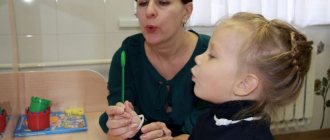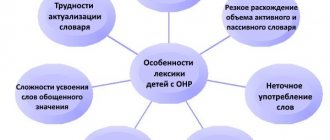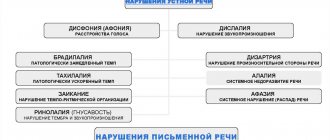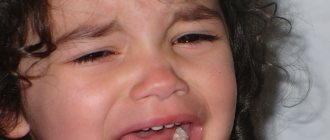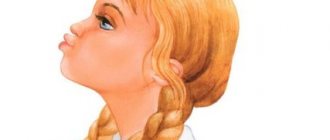The concept of praxis and its non-speech types
Gnostic functions, in turn, serve as the basis for mastering the actions associated with them, i.e. various types of praxis.
The term praxis denotes practical (objective) action. A person masters a great variety of such actions: from the simplest (eating, dressing, etc.) to the most complex, represented, for example, by professional skills and so on.
The doctrine of praxis and its disorders - apraxia - was created by the German neurologist K. Lipmann, who developed and clarified the provisions put forward by the neurologist K. Wernicke, who first described motor aphasia and introduced it into science.
K. Lipmann emphasized that praxis is a system of not only objective, but also voluntary actions. Impaired ability to reproduce these actions is called apraxia. It is fundamentally important that patients with apraxia lose the ability to perform movements and actions voluntarily.
Involuntarily, these same actions can be easily performed by them. This will be discussed in more detail in the “Apraxia” section.
K. Lipmann also drew attention to the fact that in order to perform any motor act it is necessary to perform a series of separate movements that correspond to its general plan. K. Lipmann called such a plan an “ideational sketch (sketch).”
Essentially, it represents a plan of action that unfolds into individual motor acts (“kinetic melodies”). In order for an action to take place, it is also necessary to transfer ideas about it to the executive (motor) center.
Thus, the structure of praxis as the highest mental function includes three links: ideational, transfer and executive.
A.R. Luria, based on the teachings of K. Lipmann on praxis and apraxia, significantly developed it. He divided all praxis actions into kinesthetic (sensitive) and kinetic (motor), thus postulating the presence of two types of praxis - kinesthetic and kinetic.
Kinesthetic praxis A.R. Luria designated it as afferent, and kinetic as efferent. This clarified the understanding of praxis as one of the highest mental functions, and apraxia as its pathology.
Let us add to this that the term afferent means “centripetal,” implying the direction of nerve impulses from the periphery to the center,” and the term efferent means “centrifugal,” implying the direction of nerve impulses from the center to the periphery.”
Thus, one type of praxis is kinetic in the method of acquisition and use, kinesthetic and afferent in the direction of nerve impulses. The second type of praxis is in the method of acquisition and use and efferent in the direction of nerve impulses.
In order to clarify what has been said, let us turn to the fact that the mediator between a person and his voluntary actions is an object, understood as an object of reality in the broadest sense of the word.
At first it was an object provided by nature (a stone, a tree branch, fruits, skins of killed animals, etc.), and then an object appeared that was a product of the activity of man himself, i.e. man-made. Both objects played a decisive role in shaping the practical actions of people.
In order to pick a fruit from a tree, you need to take the appropriate position, raise your hand up and make a movement of tearing the fruit off the branch; in order to catch the ball, you need to stretch both hands forward and make a catching movement; in order to take a needle, you need to connect two fingers - thumb and index - on one hand.
All these actions are different from each other and can only be performed in accordance with the configuration of the object and, what is especially important, subsequently and in the absence of the object, i.e. based on imitation of an action with a real object.
So, we can not pick a fruit from a tree, but show how it is done, not catch a real ball, but show how an imaginary ball is caught.
The totality of man-made objects made up a significant part of the civilization created by man. In the modern world, the role of the subject is not as dominant as before, but remains very important, especially in childhood.
The modern child, with his early readiness for complex types of abstract activity, nevertheless cannot do without an object, without operating with it. An adult also uses an object everywhere and every minute, but many of the secrets of object-related activity have been lost.
Suffice it to recall the colossi of the Mayan island, the pyramids of Cheops, which were made by human hands, but how exactly, now we do not understand. The secret of creating these “miracles” has been lost. But even if a person remained as skilled in manual activities, it is unlikely that he would begin to make such objects.
They have ceased to be as necessary as before (both in an aesthetic and practical sense). As a result, we are no longer surrounded by people in suits, the hand-made decoration of which amazes and touches, houses and their decoration have been simplified to geometric shapes.
The styles of pompadour, baroque, and rococo are a historical fact that has ceased to be a reality of today. True, Orthodox churches, Gothic cathedrals, and “lace” mosques of the East have still been preserved, which we can admire, but we will no longer create them in their original form, and we cannot.
During the “object-based” period of ontogenesis, a child, like our ancestors, needs a variety of objects with which he can operate. First of all, these are toys, then household items, and then everything else. The rattle can rightfully be considered the “queen” of toys.
It stimulates both visual and auditory gnosis, and carpal praxis, develops the direction of attention and activity in general.
No less “great” are dolls, cubes and pyramids. These are indispensable stimuli for developing gnosis and praxis.
The ability to perform meaningful objective actions without objects (by imitation) is called symbolic praxis. It includes all semantic gestures (how they eat, how they drink, chop wood, drive a car, etc.).
It is known that it is symbolic gestures that make up the special language of the deaf - Amslen. The verbal ability of hearing people has pushed sign language into the background, but everyone knows situations when gestures have to be used instead of words (you can’t wake someone up, you need to silently suggest something, finally, communicate something when words are not heard, for example, at the time of train departure).
Finger praxis occupies a special place. It indicates a significant degree of differentiation of hand actions. A small child very early (starting from 5-6 months) shows a love for playing with fingers.
At the same time, he develops a meaningful pointing gesture, which makes the child fundamentally different from all animals, even from a primate, which, if it can indicate something, does so with its hand, not with its finger.
A child’s love for finger actions reaches its apogee in the well-known game “Magpie-Crow.”
Even more complex than digital praxis is oral praxis. It is formed on the basis of less objective, and therefore more abstract, actions. Oral praxis movements include the ability to blow, click, click your tongue, puff out your cheeks, etc., according to instructions.
The involuntary nature of practical actions is ensured by a high degree of their strengthening (automation). This is especially clearly seen in the example of oral praxis. Involuntarily, i.e. as a reflex, the above oral movements are usually performed.
Thus, a patient who cannot blow according to instructions immediately blows out a burning match brought to his lips.
Mastering oral praxis is a very important preparatory phase of speech development. The assimilation of standard sound pronunciation largely depends on the quality and volume of oral skills.
Formation of praxis and dyspraxia in children
Developmental dyspraxia in children is the immaturity of voluntary object movements, as well as actions with a preserved intellectual level. When we talk about adults, a similar disorder that occurs after a stroke or traumatic brain injury is called apraxia (that is, the loss of already formed skills).
Let's list the childhood stages of motor development:
- Reflexes of a newborn;
- Formation of postural reactions, that is, maintaining balance and gradual verticalization (the child learns to hold his head, roll over, sit down, crawl, stand at a support, start walking and running);
- The inclusion of motor programs (crawling and walking are unconscious movements, a motor pattern, but, here, approaching an object, taking it and purposefully manipulating it is called praxis);
- Object-manipulative activity (initially unconscious, then increasingly voluntary);
- Imitation (from instincts to voluntary actions);
- Integration of stimuli received from sensory systems (proprioceptive, vestibular and kinesthetic information).
So, praxis (or voluntary movements) is based on: perception, as well as sensory integration. From the age of two we can already talk about the formation of primary praxis. According to Professor T.G. Wiesel (Doctor of Psychological Sciences), finger and manual praxis can be assessed from two and a half years of age. Oral praxis – from three years of age. From the age of four - articulatory.
Types of motor disorders in children
Violation of primary motor function (this is a violation of the elementary level of organization of movements, and not dyspraxia);
- Paresis - decreased muscle strength;
- Violation at the level of reflexes;
- Violation of tone (hypo-, hyper-, dystonia);
- Impaired balance, coordination, ataxia;
- Hyperkinesis (athetosis, chorea, tics, tremor).
Violation of sensorimotor function (we are talking about a higher level, in which it is necessary to combine several information flows and movement, that is, there is a chain of reactions “sensory input” and “motor output”):
- Difficulty with hand-eye coordination (for example, catching a ball);
- Sensory integration disorders (eg, underdevelopment of gross motor skills, gravitational uncertainty);
- Violation of the transition of the midline of the body;
- Synkinesia (unextinguished reflexes leading to the absence of differentiated, clear movements);
- Violation of bilateral coordination (impairments in interhemispheric interaction);
- Dysrhythmia.
Dyspraxia. This is already the highest level in the organization of the motor sphere. By mechanism:
- Kinesthetic dyspraxia (violation of posture, for example, articulatory posture to a particular sound or posture of fingers) - indicates that the lower parietal region of the left hemisphere is most often involved in the work;
- Kinetic or dynamic (expressed in a violation of the motor melody, the problem is observed in the switching of movement elements among themselves: switching when playing sounds, syllables, switching hand movements (for example, in the “fist-rib-palm” test) - the left premotor area of the cortex is more often involved Charles Njokiktjen, a Dutch neurologist, calls these levels “melokinetic dyspraxia” and says that this is not dyspraxia in the full sense, but a reflection of “lower” difficulties in the brain organization.
- Ideomotor dyspraxia – “true dyspraxia”, according to Njokiktien. Here the problem is different: “How to do it?”, namely a program of action. Localization - as in the previous case - premotor area, but in front of the kinetic + parieto-occipital areas of both hemispheres (depending on the type of activity).
- Ideatorial dyspraxia - “Why do?”, namely the plan of action containing intention. The prefrontal cortex is involved + all the required levels of praxis organization, which are described above, taking into account the content of the action.
You can also distinguish dyspraxia by type of activity: graphomotor, constructive, eating dyspraxia, dyspraxia of emotional expression, etc., but this is just a special case.
Types of dyspraxia by localization:
- Articulatory, verbal;
- Axial/postural;
- Oral-facial;
- Dyspraxia of the limbs, digital, manual.
Recommendations for parents for dyspraxia in children
Dyspraxia is a disorder of skill development. Training a specific skill, be it riding a bike or pronouncing sounds, will not eliminate dyspraxia. However, it is necessary to develop vital skills, and it is also very important to overcome the child’s psychological attitude of failure. Parents need to repeat the actions with the child many times, while encouraging him and removing the focus of attention from the action itself, so as not to focus on what he cannot do. Do not scold your child and, of course, do not compare with others. It is very important to lay the prerequisites for the formation of praxis, to engage in those types of activities that will put in order the “lower levels” of the organization of the motor sphere (trunk - vestibular nuclei - cerebellum - cortex).
Examples of activities: hemispheres, ortho-mats, jumpers, various balance beams, trampoline, balance bike, ball games, blind man's buff, hopscotch, catch-up, training methods with kinesiology balls and bags, swimming pool, roller skates, skating, AFK, exercise therapy, logorhythmics, kinesiology, drums, games to imitate movements (“try, repeat”, “mirror”), actions according to oral instructions (we break a complex action into parts and pronounce it step by step, as in the game “Robot”, complex ones can be in the form of a quest), development of new ways to use things and toys.
